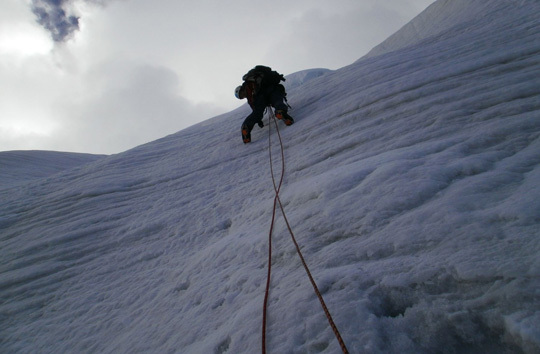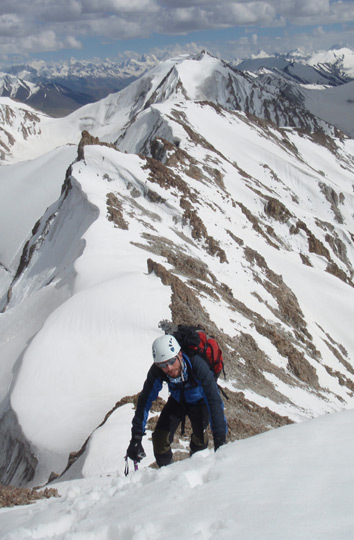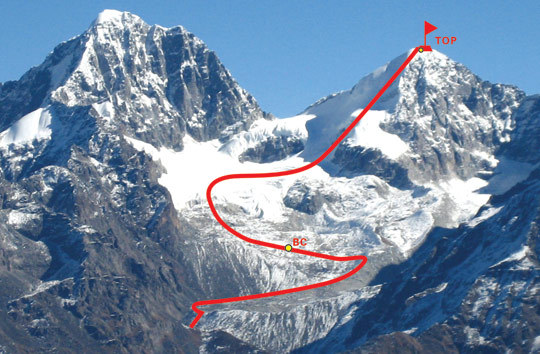
Xiaolong, Jie and Yang took two days to hike to their base camp at 4870m to access
the ice field that would lead them to their route up the west face (VI AI3+, 1400m), shown here. [Photo] Xia Zhongming
In a flurry of activity, climbers from Scotland, Germany, Portugal, Russia, Pakistan, China and Britain established new routes and first ascents in areas throughout Asia this summer, including Afghanistan, Pakistan and China.
Pakistan
In August, Russians Vjacheslav Ivanov and Oleg Koltunov climbed a new route on the west face of K7 West (6858m) in the Charakusa Valley of Pakistan. Italians Lorenzo Angelozzi and Daniele Nardi spent 10 days on the same face and though they established eight pitches over 270 meters (VII+ A2/A3), their climb was brought to an abrupt stop when rockfall destroyed their portaledge. The pair then turned to the west face of Farol West (6370m) and climbed Telegraph Road (M4/M4+ WI4 5c/6a, ca. 900m). In a 32-hour push from base camp, the pair climbed a steep snow and ice couloir and mixed terrain to the summit and, according to Lindsay Griffin of the BMC, likely established a new route. Later, Angelozzi and Nardi climbed Open Eyes (IV WI5 M5 UIAA V/V+, 400m) on a rock spire at the base of the south-southwest ridge of Farol West, which they named Punta Margherita.
Vermont-based climber Matt McCormick reported that a small crew of Swiss climbers made the first ascent of a nearby peak. The mountain they named Pathan Brakk (ca. 17,750′) is a three- or four-hour trek from K7 base camp. Though not technically difficult, McCormick said, its “steep snow climbing leads to some easy mixed climbing and then an amazing granite summit spire… [which] gave awesome views to the north of Chogolisa, Broad Peak, G4 and K2.” McCormick climbed the peak solo over two days for its second ascent. He also teamed up with partner Tim DeRoehn to complete one of the rare ascents of Tasty Talking (III 5.10+, ca. 300m), on the southeast ridge of Nayser Brakk (ca. 5200m). They summited in a pouring rainstorm, McCormick said.
In the Chiche Valley, south of the Rupal Valley in the Nanga Parbat Range, Germans Christian Walter and Stefan Wolf managed to avoid the flooding occurring in other parts of Pakistan and ascended an unclimbed, 5860-meter peak. They set up base camp at 3800m and bivouacked on the route at 5200m before reaching the summit at 3 p.m. on August 11. The team also climbed new routes on smaller peaks nearby to acclimatize. They opened Breathless (UIAA VII, 450m) on Shalmuki (5068m) on August 1, scrambled Nilo Peak (UIAA III, 4986m) on August 4 and on August 5 climbed 45-degree ice ramps and UIAA III-grade rock to the summit of Gerd Markert Peak (4966m), which they named after a German climber who had died in the weeks before. The pair had an adventurous journey back to Islamabad due to the flooding, which had washed out many bridges and roads and caused landslides.
In the Nangma Valley of Pakistan, Portuguese climbers Leopoldo Faria, Rui Rosado, Ana Silva and Bruno Gaspar established Off-Dido (7a+, 550m) on the Babar Wall. Unfortunately, just two pitches from the summit a small hold broke for Faria, who fell 12 meters and crashed into a small ledge, breaking his wrist and rupturing foot ligaments. It took the team four hours to descend the route. Off-Dido presented mainly crack climbing, at times filled with plants and dirt, and some off-width climbing.
In the Hunza-Giligit region, Samina Baig (aka Samina Khayal) made the first ascent of Chashkin Sar (6400m) in Shimshal, Upper Hunza, at the age of 18. The rising Pakistani star climbed with her brother, Mirza Ali, a Romanian filmmaker and photographer, Stelian Pavalache, as well as Tafat Shah, Yahya Baig, Salamat Khan and Arshad Karim. The expedition was launched by Pakistan Youth Outreach, an educational youth mountaineering program that promotes women adventurers. The peak has been renamed Samina Peak.
China
On July 24, a team of Chinese mountain guides, Xiaolong Peng, Jie Gu and Yang Liu, made the first ascent of an unnamed peak (5662m) in the Daxue Shan mountain range, which is located 17km southwest of Kangding City in the Sichuan Province of China. The 1400m climb (VI AI3+) began with a two-day approach to a base camp at 4870m.
Waking at 4 a.m., the climbers hiked two hours to the tongue of the glacier, climbed 60 meters of 60-degree ice to reach an ice field, which led them to the west face of the peak. From the bergschrund they climbed the direttissima up the face, with Xiaolong leading the first four pitches, Yang leading the next six and Jie leading the final three pitches to the summit. The team topped out at 5:20 p.m. and arrived back in Base Camp at 2 a.m. on July 25.
Also this summer, in the Chinese Xinjiang region, Brits Mick Fowler and Paul Ramsden established the first ascent of the North Face of Sulamar (TD+, ca. 5380m), an impressive peak hugging the northern edge of the Xuelian Massif. On the six-day round trip from base camp, the pair climbed 1600 meters of mixed terrain on the central buttress to the summit. Fowler and Ramsden also planned to climb the North West Ridge of Xuelian East, but crevasse falls amid deep snow on the 25km glacier approach brought those plans to a halt.
After three attempts during their time in the Quonglai Mountains of Sichuan, China, Dylan Johnson and Chad Kellogg reached the unclimbed summit of Seerdengpu (5592m) on September 13. Details will follow in a forthcoming NewsWire report.
Afghanistan

On their exit from Alan Halewood’s successful ascent of Koh-e-Iksander, he and
partner Gwynne climbed Koh-e-Khar (5327m), a mountain with two peaks that resembled
donkey ears. Here, Gwynne approaches the first of the two donkey ear summits. [Photo] Alan Halewood
In the remote Wakhan Corridor of northeastern Afghanistan, Alan Halewood, of Fort William, Scotland, established the first ascent of a remote and unnamed peak, which he named Koh-e-Iksander (5561m). Throughout the end of July and early August, Halewood and partner, Neal Gwynne, of Glasgow, spent two days of four-wheel driving and eight days of trekking with pack horses to reach their base camp. Upon reaching a col at the head of a glacier, Gwynne turned around and Halewood continued alone to the summit. Halewood said that perhaps no Westerner and maybe no human being had ever seen the peak. Halewood and Gwynne also climbed another mountain with two peaks resembling donkey ears, which they named Koh-e-Khat (5327m), which means Peak of the Donkey.

In late July, Chinese guides Xiaolong Peng, Jie Gu and Yang Liu made the first ascent
of this unnamed peak (5662m) in the Daxue Shan mountain range. [Photo] Xia Zhongming

This summer, among dozens of other first ascents across the greater ranges of Asia,
Scottish mountaineer Alan Halewood made the first ascent of Koh-e-Iksander (5561m). The
mountain was so remote that Halewood said perhaps no humans had ever before set eyes on it. [Photo] Neal Gwynne

Pathan Brakk (ca. 17,750′), Charakusa Valley, Karakoram, Pakistan. This summer,
a Swiss team climbed and named this peak; a couple weeks later, Matt McCormick soloed it to
acclimatize. [Photo] Matt McCormick